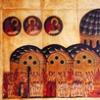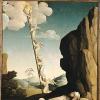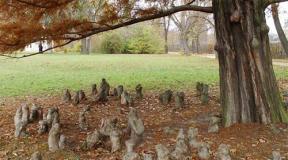The Sphinx is the largest. The meaning of the Great Sphinx in Egyptian mythology
Let's try to understand the purpose of its creation and the methods of its construction. Let's find out what they say in scientific world about the age of the Sphinx. What does it hide inside and what role does it play in relation to the pyramids? Let's weed out fiction and assumptions, leaving only scientifically proven facts.
Brief description of the Sphinx in Egypt
Sphinx and 50 jets
The Sphinx in Egypt is the largest surviving sculpture of antiquity. The length of the body is 3 compartment cars (73.5 m), and the height is 6 storey house(20 m). The bus is smaller than one front paw. And the weight of 50 jet airliners is equal to the weight of a giant.
The blocks from which the paws are made were added during the New Kingdom period to restore the original appearance. The sacred Cobra, nose and ritual beard - symbols of the power of the pharaohs - are missing. Fragments of the latter are on display in the British Museum.
Remnants of the original dark red paint can be seen near the ear.
What could the strange proportions mean?
One of the main abnormalities of the figure is the disproportion of the head and torso. It appears that the upper part was rebuilt several times by subsequent rulers. There are opinions that at first the head of the idol was either a ram or a falcon and later turned into a human form. Restorations and renovations over many thousands of years could have reduced the head or enlarged the torso.
Where is the Sphinx?
The monument is located in the necropolis of Memphis next to the pyramidal structures of Khufu (Cheops), Khafre (Chephren) and Menkaure (Mycerinus) about 10 km from Cairo, on the western bank of the Nile River on the Giza Plateau.
God in reverse or what the giant symbolizes
In Ancient Egypt, the figure of the Lion personified the power of the pharaohs. In Abydos, the cemetery of the first Egyptian kings, archaeologists discovered about 30 skeletons of adults who were under 20 years old, and... the bones of lions. The gods of the ancient Egyptians were always depicted with the body of a man and the head of an animal, but here it’s the other way around: a man’s head the size of a house on the body of a lion.
Maybe this suggests that the power and strength of the lion combined with human wisdom and the ability to control this power? But to whom did this strength and wisdom belong? Whose facial features are carved in stone?
Unraveling the secret of construction: interesting facts
The world's leading Egyptologist Mark Lehner spent 5 years next to the mysterious creature, studying him, the materials and rock around him. He compiled detailed map statues and came to a clear conclusion: the statue was carved from limestone, which lies at the base of the Giza plateau.
First, they hollowed out a trench in the shape of a horseshoe, leaving a huge block in the center. And then the sculptors carved a monument out of it. Blocks weighing up to 100 tons for the construction of the walls of the temple in front of the Sphinx were taken from here.
But this is only part of the solution. The other is how exactly did they do it?
Together with Rick Brown, an expert on ancient tools, Mark reproduced the tools depicted in tomb drawings that were over 4,000 years old. These were copper chisels, a two-handed pestle and a hammer. Then, with these tools, they cut out a detail of the monument from the limestone block: the missing nose.
This experiment made it possible to calculate that they could have worked on creating the mysterious figure one hundred sculptors during three years . At the same time, they were accompanied by a whole army of workers who created tools, hauled away rock and did other necessary work.
Who broke the colossus' nose?
When Napoleon arrived in Egypt in 1798, he saw a mysterious monster without a nose, which is proven by drawings of the 18th century: the face was like this long before the arrival of the French. Although one may come across the opinion that the nose was recaptured by the French military.
There are other versions. For example, it is called the shooting of Turkish (according to other sources - English) soldiers, whose target was the face of an idol. Or there is a story about a fanatical Sufi monk in the 8th century AD who mutilated a “blasphemous idol” with a chisel.
Fragments of the ritual beard of the Egyptian Sphinx. British Museum, Photo from EgyptArchive
Indeed, there are traces of wedges driven into the bridge of the nose and near the nostril. It looks like someone hammered them in on purpose to break off the part.
Prophetic dream of the prince at the Sphinx
The monument was saved from complete destruction by the sands that covered it for millennia. Attempts to restore the colossus have been made since Thutmose IV. There is a legend that while hunting, resting in the midday shade of a structure, the king’s son fell asleep and had a dream. The giant deity promised him the crown of the Upper and Lower Kingdoms and in return asked him to free him from the consuming desert. The granite Dream Stele, installed between the paws, preserves this history.

Drawing of the Great Sphinx 1737 Hood. Frederic Norden
The prince not only dug up the deity, but also surrounded him with a high stone wall. At the end of 2010, Egyptian archaeologists excavated areas brick wall, which stretches 132 m around the monument. Scientists believe that this is the work of Thutmose IV, who wants to protect the statue from drifts.
The story of the grief-restoration of the Sphinx in Giza
Despite the efforts, the structure was filled up again. In 1858, part of the sand was cleared by Auguste Mariette, founder of the Egyptian Antiquities Service. And in the period from 1925 to 1936. French engineer Emile Barais completed the clearing completely. Perhaps for the first time, the divine beast was once again exposed to the elements.
It is also clear that the statue is being destroyed by wind, humidity and exhaust fumes from Cairo. Realizing this, the authorities are trying to preserve the ancient monument. In the last century, in 1950, a huge and expensive restoration and conservation project was started.
But on initial stage work, instead of benefit, only caused additional damage. The cement used for repairs, as it turned out later, was incompatible with limestone. Over 6 years, more than 2,000 limestone blocks were added to the structure, and chemical treatment, but... this did not bring a positive result.
How M. Lehner guessed who the Great Sphinx of Egypt depicts

Excavations of the Temple of Khafre (foreground).
The Kheop Pyramid is in the background.
Photograph by Henri Bechard, 1887
The tombs of the pharaohs change their shape and size over time. And appear. And the Great Sphinx is the only one.
A significant number of Egyptologists believe that he represents Pharaoh Khafre (Hawr) from the fourth dynasty, because. a similar small stone silhouette with his face was found nearby. The sizes of the blocks of Khafre's tomb (circa 2540 BC) and the monster also match. Despite their claims, no one knows for sure when and by whom this statue was installed in Giza.
Mark Lehner found the answer to this question. He studied the structure of the Sphinx Temple, which is located 9 meters away. On the days of the spring and autumn equinox, the sun at sunset connects the two sanctuaries of the temple and the pyramid of Khafre with one line.
The religion of the ancient Egyptian kingdom was based on the worship of the Sun. Local residents worshiped the idol as an incarnation of the Sun God, calling it Khor-Em-Akhet. Comparing these facts, Mark determines the original purpose of the Sphinx and his identity: Khafre's face the son of Cheops, looks from the figure of a god who protects the pharaoh's journey to the afterlife, making it safe.
In 1996, a New York detective and identification expert revealed that the resemblance was more noticeable to Khafre's older brother Djedefre (or son, according to other sources). The debate on this topic is still ongoing.
How old is the giant anyway? Writer vs. Scientists

Explorer John Anthony West
There is now a lively debate about the dating of the monument. Writer John Anthony West was the first to notice marks on the lion's body. one erosion. Other structures on the plateau show wind or sand erosion. He contacted geologist and associate professor at Boston University Robert M. Schoch, who, after studying the materials, agreed with West's conclusions. In 1993, their collaboration“The Secret of the Sphinx,” which received an Emmy Award for Best Research and a nomination for Best Documentary.
Although today this area is arid, about 10,000 years ago the climate there was humid and rainy. West and Schoch concluded that for the observed effects of water erosion to occur, the age of the Sphinx must be from 7000 to 10,000 years.
Scientists have rejected Schoch's theory as wildly flawed, pointing out that the once common violent rain storms across Egypt had ceased before the sculpture's appearance. But the question remains: why was it only this Giza structure that showed signs of water damage?
Spiritual and supernatural interpretations about the purpose of the Sphinx
The famous English journalist Paul Brunton spent a lot of time traveling in Eastern countries, lived with monks and mystics, studied history and religion Ancient Egypt. He explored royal tombs and met famous fakirs and hypnotists.
His favorite symbol of the country, a mysterious giant, told him its secrets during a night spent in the Great Pyramid. The book “In Search of Mystical Egypt” tells how one day the secret of all things was revealed to him.
American mystic and prophet Edgar Cayce is confident in the theory that can be read in his book about Atlantis. He pointed out that the secret knowledge of the Atlanteans was kept next to the Sphinx.

Sketch by Vivant Duvon from 1798. Shows a man emerging from a hole in the top.
Writer Robert Bauval published an article in 1989 that the three pyramids at Giza, relative to the Nile, formed a kind of three-dimensional "hologram" on the ground of the three stars of Orion's belt and the Milky Way. He developed a complex theory that all the structures of a given area, together with the ancient Scriptures, constitute an astronomical map.
The most suitable position of the stars in the sky for this interpretation was in 10500 BC. BC. This date is understandably disputed by Egyptologists, since not a single archaeological artifact dating from these years has been excavated here.
New riddles of the Sphinx in Egypt?
There are various legends about secret passages associated with this artifact. Research by the University of Florida and Boston University, as well as Waseda University in Japan, revealed various anomalies around the figure. Although, it is possible that these are natural features.
In 1995, workers renovating a nearby parking lot came across a series of tunnels and paths, two of which plunge underground not far from the stone body of the man-beast. R. Bauval is convinced that these structures are the same age.
Between 1991 and 1993, while studying damage to the monument using a seismograph, Anthony West's team discovered correct form hollow spaces or chambers located at a depth of several meters between the forelimbs and on either side mysterious image. But permission for a deeper study was not received. The mystery of the underground rooms has not yet been solved.
The Sphinx in Egypt continues to excite inquiring minds. There are many conjectures and assumptions surrounding the most ancient monument on our planet. Will we ever find out who and why left this mark on Earth?
It is interesting to know your opinion, write it in the comments.
Please rate this article by selecting the desired number of stars below.
Share with your friends on in social networks to discuss the secrets and riddles of the Sphinx of Egypt when we meet.
Read more interesting materials on the Zen channel
Another proof was presented to us by the Japanese scientist Sakuji Yoshimura in 1988. He was able to determine that the stone from which the Sphinx was carved was older than the blocks of the pyramids. He used echolocation. Nobody took him seriously. Indeed, age rock It is impossible to determine by echolocation.
The only serious evidence of the “theory of the antiquity of the Sphinx” is the “Inventory Stele”. This monument was found in 1857 by Auguste Mariet, the founder of the Cairo Museum (pictured left).
On this stele there is an inscription that Pharaoh Cheops (Khufu) found the Sphinx statue already buried in the sand. But this stele was created during the 26th dynasty, that is, 2000 years after the life of Cheops. Don't trust this source too much.
One thing we can say for sure is that the Sphinx has the head and face of a pharaoh. This is evidenced by the nemes (or claft) headdress (see photo) and decorative element uraeus (see photo) on the forehead of the sculpture. These attributes could only be worn by the pharaoh of Upper and Lower Egypt. If the statue's nose had been preserved, we would have been closer to the answer.
By the way, where is the nose?
The dominant version in the public consciousness is that the nose was knocked down by the French in 1798-1800. Napoleon then conquered Egypt, and his gunners practiced shooting at the Great Sphinx.

This is not even a version, but a “fable”. In 1757, traveler Frederik Louis Norden from Denmark published sketches he made in Giza, and the nose was no longer there. At the time of publication, Napoleon had not even been born. You can see the sketch in the photo on the right; there really is no nose.
The reasons for the accusations against Napoleon are clear. The attitude towards him in Europe was very negative, he was often called a “monster”. As soon as there was a reason to accuse someone of damaging the historical heritage of mankind, of course, he was chosen as the “scapegoat”.
As soon as the version about Napoleon began to be actively refuted, a second, similar version arose. It says that the Mamluks fired cannons at the Great Sphinx. We cannot explain why public opinion is so drawn to hypotheses involving guns? It’s worth asking sociologists and psychoanalysts about this. This version also has not received confirmation.
A proven version of the loss of the nose was expressed in the work of the Arab historian al-Makrizi. He writes that in 1378 the nose of the statue was knocked off by a religious fanatic. He was outraged that the inhabitants of the Nile Valley worshiped the statue and brought gifts to it. We even know the name of this iconoclast - Muhammad Saim al-Dakhr.

Nowadays, scientists have conducted research in the area of the Sphinx's nose and found traces of a chisel, that is, the nose was broken off with this very tool. There are two such marks in total - one chisel was driven under the nostril, and the second from above.
These traces are small and a tourist cannot notice them. However, you can try to imagine how this fanatic could do it. Apparently, he was lowered down on a rope. The Sphinx lost his nose, and Saim al-Dakhr lost his life; he was torn to pieces by the crowd.
From this story we can conclude that the Sphinx was still an object of cult and worship by the Egyptians in the 14th century, although almost 750 years had already passed since the beginning of Arab rule.
There is another version of the statue’s loss of its nose – natural causes. Erosion destroys the statue and even part of its head falls off. It was installed back during the last restoration. And this statue had many restorations.
The Egyptians built sphinx statues over the tombs of the pharaohs. In the suburbs of Cairo, there is the oldest Great Sphinx on the planet. The statue is carved from limestone and depicts a huge lion with a human face.
The history of the appearance of the statue
The Egyptian Sphinx monument is located near the Pyramid of Cheops. Between the paws of the statue there is an inscription stating that the monument is a copy of the Sun God - Khamarkis. According to one version, the face of the statue is made in the likeness of Pharaoh Khafre. It was created during his reign - 2520-2494 BC. e.
Many years later, the statue was discovered under a mound of sand and restored by Pharaoh Thutmose IV. Among the Egyptians there are legends about the capabilities of the Sphinx statue not only to protect tombs and souls of the dead, but also to move around.
The Sphinx changes its location when it is dissatisfied with something - the government or the attitude towards itself. He goes into the desert, where he buries himself deep in the sand. Pharaoh dreamed of God and said that his body was covered with sand and asked for help, indicating exact location statues. During the excavations, a statue was discovered, the severed head of which rested peacefully between its paws.
The steps leading up to the statue were built much later, during the Roman Empire. The Romans were involved in the reconstruction of most Egyptian monuments. When they discovered a recess on the head of the statue, people thought that this was a secret entrance to the pyramid, but in fact it turned out that this was the place where the headdress was attached, which was lost in a sandstorm.

Previously it was believed that secret passages were built in the sphinx, but after lengthy research, it was possible to prove that the body was built from a rocky ledge, and the front part consisted of separate stone parts.
Pedestal dimensions:
- length - 73.5 m;
- height - 20 m.
The material of the statue was examined by injecting metal pipes. Detailed analyzes made it possible to identify the remains of mumillites - tiny sea inhabitants.
This proves that the rock for the sculpture was brought to this place using an unknown transport structure. The second version says that the monument was built from local rock, which in appearance was similar to the sphinx originally.
The Sphinx was considered a portal between our world and the Great Pyramid. Between the paws of the statue there was an entrance, and inside there was a labyrinth, wandering through which the person came to the starting point. Location correct moves was known to the Egyptian priests.
In the labyrinth, travelers were looking for a bronze door that would open the mysterious World of the Pyramid and the key to the wisdom of the gods. No evidence of its existence was found. If we assume that there was a door, then it is littered with debris and sand, because over time the statue was badly damaged.
The sculpture reached us in a disfigured form. Her nose was beaten off by the Muslim conquerors so that the faithful would renounce idolatry, and on her face there are barely visible traces of red paint. For the Egyptians, the statue remained a symbol of wisdom and the personification of physical strength.
Place of the Sphinx in Greek mythology
In mythology Ancient Greece, the sphinx is a creature that was depicted as a half-woman, half-lion with the wings of a bird. The demoness-strangler personified the inevitability of fate, human suffering and torment. In some legends, her parents were Tryphon and Echidna, in others - Chimera and Orff.

Hera sent the sphinx to Thebes to devastate the territories and punish Laem for seducing Chryssipus. Another version says that the creature was sent by Ares to Thebes to avenge the slain dragon. The creature chose a cave on a mountain not far from the city gates for its habitat. The sphinx gave each traveler the task of solving a riddle. She killed people who failed to complete the task. Many noble Thebans became its victims, among whom was the son of King Creon, Haemon.
Oedipus solved the riddle. After this, the Sphinx threw herself from the mountain in despair. This is the interpretation according to Euripides. Aeschylus told the story differently. In his version, the Sphinx herself guessed Silenus's riddle. The ancient Boeotian version of the story describes a monster called Fix. It swallowed its victims and lived on Mount Fikion. During a fierce battle, Oedipus killed the ferocious creature.

Sphinxes among other peoples
The mythical creature occupied a certain place in the mythology of the Persians, Assyrians and Phoenicians. In their legends, the creature is depicted in male form with a beard and long curly hair. A little later, the image was modernized and legends began to mention female and male individuals. Here the sphinxes were revered for their wisdom.
Sphinxes have centuries-old knowledge, speak all languages and master forgotten types of magic. They are presented as adepts in the use of spells in magical rituals. Creatures love jewelry and books.
Males are described as large, with enormous physical strength creatures. In a fit of anger, challenging the sphinx, it emits a deafening roar that can be heard for hundreds of miles around. Females much smarter, endowed with wisdom, inclined to help people. They patronize poets and philosophers.

Sphinx in Egyptian mythology
The true purpose of the Egyptian Sphinx:
- guard the house of the gods;
- teach people wisdom;
- indicate Right way to knowledge;
- personify the god Harmachis on earth.
God Harmachis is one of the hypostases of young Ra. The parents of the divine essence were Osiris and Isis. Set killed Osiris before Harmachis was conceived, but his wife used magic to bring him back to life. A little later, Set dismembered Osiris and scattered his remains around the world, in the hope that Isis would no longer be able to resurrect him. The goddess had to hide from Set for a long time in the swamps of the Nile in order to keep the child in the womb.
At the moment of the deity’s birth, a red star lit up in the sky. The mother protected her child with magic until he came of age. Throughout his childhood and adolescence, Harmachis successfully studied and gave knowledge to others. At the age of 30, he had 12 disciples who helped heal the sick.
The matured Harmachis entered into a duel with Seth to avenge his father. During the battle, Seth tore out the young man's eye, but the young god, not at a loss, returned it to himself and, having killed Seth, took away the male nature of the enemy. Using his eye, he resurrected his father and became the rightful ruler of Egypt. He was identified with victory and the power of justice.
There is a legend in which Seth is the personification of darkness, and Harmachis is the personification of light. Their fight was not the only one, but lasted for an eternity, starting at dawn and ending at dusk. Their battle is an eternal struggle between good and evil.
Some monumental structures depict the Egyptian Sphinx as a lion with a falcon's head and one large eye in its forehead. The Egyptians believed that God had the gift of clairvoyance, which helped him distinguish truth from lies every time. By placing his eye on a sick person, he helped to gain clear thoughts and see the resolution of a difficult situation. The magic of God was the ability to see with eyes full of love, without prevarication, without being selective and without harboring malice in the heart.
A little later, the interpretation of the god-ruler was relegated to the background, since persons of non-royal blood began to be allowed into power, which radically changed the attitude towards the pharaohs. Kharmakhis became no longer supreme god, and the son of the god Ra. Subsequently, the divine descendant was betrayed by one of his students. Harmachis was crucified on the cross and buried. He lay there for 3 days and then resurrected.

Historical mysteries
There is still controversy regarding the origin of the Egyptian Sphinx. Its existence is surrounded by secrets and mysteries:
- There are 3 underground passages under the monument. We managed to find only one, located behind the head of the statue.
- The exact time of the monument's appearance could not be determined. There is historical evidence that it was built long before the reign of Pharaoh Khafre.
- Accusations of the French Emperor Napoleon and his army of destroying the face of the statue may be groundless, because... There are sketches by an ancient traveler depicting a pedestal without a nose and they are dated to a time when Bonaparte was not yet born.
- There is not a single mention of the construction of the monument in the records of the Egyptians. The people carefully documented information about the costs of all construction.
- The first mentions of the statue are found in the records of Pliny the Elder. They contain information about the excavations during which the monument was freed from sand captivity.

Restoration work
The first pharaoh who managed to completely free the statue from sand was Thutmose IV. Later, Ramses ordered the monument to be dug up. Then restoration attempts were made in the 19th-20th centuries.
Nowadays, active work is underway to restore and strengthen the monument. The statue was closed for 4 months and the composition of the material was carefully analyzed and the possibilities of strengthening the foundation were determined. All cracks were isolated using modern building materials. The monument became accessible to tourists in 2014.

The Great Sphinx is one of the most valuable statues in Egypt. Scientists around the world are still working on the mysteries of the monument. There is no documentation regarding its origin, so it was never possible to fully understand when it was built. In mythology, the sphinx appears to people in different forms. Carries the wisdom of centuries, helps shed light on solving complex problems and is the guardian of the world of the gods.
Having heard the combination of the words “Ancient Egypt”, many will immediately imagine majestic pyramids and the large Sphinx - it is with them that a mysterious civilization separated from us by several millennia is associated. Let's get to know interesting facts about sphinxes, these mysterious creatures.
Definition
What is a sphinx? This word first appeared in the Land of the Pyramids, and later spread throughout the world. So, in ancient Greece you can find a similar creature - beautiful woman with wings. In Egypt, these creatures were most often masculine. The sphinx with the face of the female pharaoh Hatshepsut is famous. Having received the throne and pushed aside the rightful heir, this powerful woman tried to rule like a man, even wearing a special false beard. Therefore, it is not surprising that many statues of this time have found her face.

What function did they perform? According to mythology, the sphinx acted as the guardian of tombs and temple buildings, which is why most of the statues that have survived to this day were discovered near such structures. Thus, in the temple of the supreme deity, solar Amun, approximately 900 of them were found.
So, answering the question of what a sphinx is, it should be noted that this is a statue characteristic of the culture of Ancient Egypt, which, according to mythology, guarded temple buildings and tombs. The material used for creation was limestone, which was quite abundant in the Country of the Pyramids.

Description
The ancient Egyptians depicted the Sphinx like this:
- The head of a person, most often a pharaoh.
- The body of a lion, one of the sacred animals of the hot country of Kemet.
But this appearance is not the only option for depicting a mythological creature. Modern finds prove that there were other species, for example with the head:
- ram (the so-called cryosphinxes, installed near the temple of Amun);
- Falcon (they were called hieracosphinxes and were most often placed near the temple of the god Horus);
- hawk

So, answering the question of what a sphinx is, it should be pointed out that it is a statue with the body of a lion and the head of another creature (usually a person, a ram), which was installed in the immediate vicinity of temples.
The most famous sphinxes
The tradition of creating very original statues with human head and the lion's body was characteristic of the Egyptians for a long time. So, the first of them appeared during the fourth dynasty of the pharaohs, that is, around 2700-2500. BC e. Interestingly, the first representative was female and portrayed Queen Hetethera the Second. This statue has reached us; anyone can look at it in the Cairo Museum.
Everyone knows Great Sphinx in Giza, which we will talk about below.
The second largest sculpture depicting an unusual creature is an alabaster creation with the face of Pharaoh Amenhotep II, discovered in Memphis.
No less famous is the famous Avenue of the Sphinxes near the Temple of Amun in Luxor.

Greatest value
The most famous throughout the world, of course, is the Great Sphinx, which not only amazes with its enormous size, but also poses many mysteries to the scientific community.
The giant with a lion's body is located on the plateau at Giza (near the capital of the modern state, Cairo) and is part of a funerary complex that also includes three great pyramids. It was carved from a monolithic block and is the largest structure for which solid stone was used.

Even the age of this outstanding monument is controversial, although analysis of the rock suggests that it is at least 4.5 millennia old. What features of this colossal monument are known?
- The face of the Sphinx, disfigured by time and, as one legend says, by the barbaric actions of the soldiers of Napoleon's army, most likely depicts Pharaoh Khafre.
- The giant's face is turned to the east, which is where the pyramids are located - the statue seems to protect the peace of the greatest pharaohs of antiquity.
- The dimensions of the figure, carved from monolithic limestone, are amazing: length - more than 55 meters, width - about 20 meters, shoulder width - more than 11 meters.
- Previously, the ancient sphinx was painted, as evidenced by the surviving remains of paint: red, blue and yellow.
- The statue also had a beard, typical of the kings of Egypt. It has survived to this day, although separately from the sculpture - it is kept in the British Museum.
The giant found himself buried under the sand several times and was dug up. Perhaps it was the protection of the sand that helped the Sphinx survive the destructive influence of natural disasters.
Changes
The Egyptian Sphinx managed to defeat time, but it affected the change in its appearance:
- Initially, the figure had a traditional pharaonic headdress, decorated with a sacred cobra, but it was completely destroyed.
- The statue also lost its false beard.
- Damage to the nose has already been mentioned. Some blame this on the shelling of Napoleon's army, others on the actions of Turkish soldiers. There is also a version that the protruding part was damaged by wind and humidity.
Despite this, the monument is one of the greatest creations of the ancients.

Mysteries of history
Let's get acquainted with the secrets of the Egyptian Sphinx, many of which have not yet been solved:
- Legend has it that there are three underground passages under the giant monument. However, only one of them was found - behind the giant's head.
- The age of the largest sphinx is still unknown. Most scholars believe that it was built during the reign of Khafre, but there are those who consider the sculpture to be more ancient. Thus, her face and head retained traces of the influence of the water element, which is why the hypothesis arose that the giant was erected more than 6 thousand years ago, when a terrible flood hit Egypt.
- Perhaps the army of the French emperor is wrongly accused of causing damage to the great monument of the past, since there are drawings by an unknown traveler in which the giant is already depicted without a nose. Napoleon was not yet born at that time.
- As you know, the Egyptians knew writing and documented in detail everything on papyri - from conquests and the construction of temples before taxes were collected. However, not a single scroll was found that contained information about the construction of the monument. Perhaps these documents simply have not survived to this day. Perhaps the reason is that the giant appeared long before the Egyptians themselves.
- The first mention of the Egyptian Sphinx was found in the works of Pliny the Elder, which talks about the work of excavating the sculpture from sand.
Majestic monument Ancient world has not yet revealed all his mysteries to us, so his research continues.

Restoration and protection
We learned what the Sphinx is, what role it played in the worldview ancient Egyptian. They tried to dig out the huge figure from the sand and partially restore it even under the pharaohs. It is known that similar work was carried out during the time of Thutmose IV. A granite stele has been preserved (the so-called “Dream Stele”), which tells that one day the pharaoh had a dream in which the god Ra ordered him to cleanse the statue of sand, in return promising power over the entire state.
Later, the conqueror Ramses II ordered the excavation of the Egyptian Sphinx. Attempts were then made in early XIX and XX centuries.
Now let's see how our contemporaries are trying to preserve this cultural heritage. The figure was carefully analyzed, all the cracks were identified, the monument was closed to the public and restored within 4 months. In 2014 it was reopened to tourists.
The history of the Sphinx in Egypt is amazing and filled with secrets and riddles. Many of them have not yet been solved by scientists, so the amazing figure with the body of a lion and the face of a man continues to attract attention.
Egypt is a country that is still shrouded in a lot of mysteries that attract tourists from all over the planet. Perhaps one of the most important secrets of this state is the great Sphinx, the statue of which is located in the Giza Valley. This is one of the most grandiose sculptures ever created by human hands. Its dimensions are truly impressive - the length is 72 meters, the height is approximately 20 meters, the face of the Sphinx itself is 5 meters long, and the nose that fell off, according to calculations, was the size of an average human height. Not a single photo can convey the full grandeur of this stunning ancient monument.
Today, the Great Sphinx in Giza no longer inspires sacred horror in a person - after excavations it was discovered that the statue was just “sitting” in a hole. However, for many centuries, her head, sticking out of the desert sand, inspired superstitious fear among desert Bedouins and local residents.
general information
The Egyptian Sphinx is located on the west coast of the Nile River, and its head faces the sunrise. For many thousands of years, the gaze of this silent witness to the history of the land of the Pharaohs has been directed to that point on the horizon where, on the days of the autumn and spring equinoxes, the sun begins its leisurely course.
The Sphinx itself is made of monolithic limestone, which is a fragment of the base of the Giza plateau. The statue represents a huge mysterious creature with the body of a lion and the head of a man. Many have probably seen this grandiose building in photographs in books and textbooks on the history of the Ancient World.
Cultural and historical significance of the structure
According to historians, in almost all ancient civilizations the lion was the personification of the sun and solar deity. In the drawings of the ancient Egyptians, the pharaoh was often depicted as a lion, attacking the enemies of the state and exterminating them. It was on the basis of these beliefs that the version was built that the great Sphinx is a kind of mystical guard protecting the peace of the rulers buried in the tombs of the Giza Valley.

It is still not known what the inhabitants of Ancient Egypt called the Sphinx. It is believed that the word “sphinx” itself is of Greek origin and is literally translated as “strangler.” In some Arabic texts, in particular in the famous collection “A Thousand and One Nights,” the Sphinx is called nothing less than “Father of Terror.” There is another opinion, according to which the ancient Egyptians called the statue “the image of being.” This once again confirms that the Sphinx was for them the earthly incarnation of one of the deities.
Story
Probably the most important mystery that the Egyptian Sphinx conceals is who, when and why erected such a grandiose monument. In the ancient papyri found by historians, one can find a lot of information about the construction and creators of the Great Pyramids and numerous temple complexes, but there is no mention of the Sphinx, its creator and the cost of its construction (and the ancient Egyptians were always very careful about the costs of this or that business). not in any source. The historian Pliny the Elder mentioned it for the first time in his writings, but this was already at the beginning of our era. He notes that the Sphinx, located in Egypt, has been reconstructed and cleaned of sand several times. It is precisely the fact that not a single source has yet been found that explains the origin of this monument, which has given rise to countless versions, opinions and guesses as to who built it and why.
The Great Sphinx fits perfectly into the complex of structures located on the Giza plateau. The creation of this complex dates back to the reign of the IV dynasty of kings. Actually, it itself includes the Great Pyramids and the statue of the Sphinx.

It is still impossible to say exactly how old this monument is. According to the official version, the Great Sphinx in Giza was erected during the reign of Pharaoh Khafre - approximately 2500 BC. In support of this hypothesis, historians point to the similarity of the limestone blocks used in the construction of the pyramid of Khafre and the Sphinx, as well as the image of the ruler himself, which was discovered not far from the building.
There is another, alternative version of the origin of the Sphinx, according to which its construction dates back to even more ancient times. A team of Egyptologists from Germany, who analyzed the erosion of the limestone, concluded that the monument was built around 7000 BC. There are also astronomical theories about the creation of the Sphinx, according to which its construction is associated with the constellation Orion and corresponds to 10,500 BC.
Restorations and the current state of the monument
The Great Sphinx, although it has survived to this day, is now badly damaged - neither time nor people have spared it. The face was especially damaged - in numerous photographs you can see that it is almost completely erased, and its features cannot be distinguished. Uraeus - symbol royal power, which represents a cobra that wraps itself around its head, is irretrievably lost. The plat - the ceremonial headdress that descends from the head to the shoulders of the statue - is also partially destroyed. The beard, which is now not fully represented, has also suffered. But where and under what circumstances the Sphinx’s nose disappeared, scientists are still arguing.
Damage to the face of the Great Sphinx, located in Egypt, is very reminiscent of chisel marks. According to Egyptologists, in the 14th century it was mutilated by a pious sheikh who carried out the covenants of the Prophet Muhammad, which prohibited depicting a human face in works of art. And the Mamelukes used the head of the structure as a cannon target.

Today, in photos, videos and live, you can see how much the Great Sphinx has suffered from time and the cruelty of people. A small piece weighing 350 kg even broke off from it - this gives another reason to be amazed at the truly gigantic size of this structure.
Although only 700 years ago the face of the mysterious statue was described by a certain Arab traveler. His travel notes said that this face was truly beautiful, and his lips bore the majestic seal of the pharaohs.
Over the years of its existence, the Great Sphinx has more than once plunged up to its shoulders into the sands of the Sahara Desert. The first attempts to excavate the monument were made in ancient times by the pharaohs Thutmose IV and Ramses II. Under Thutmose, the Great Sphinx was not only completely dug out of the sand, but also a huge granite arrow was installed in its paws. An inscription was carved on it, saying that the ruler was giving his body under the protection of the Sphinx so that it would rest under the sands of the Giza Valley and at some point be resurrected in the guise of a new pharaoh.
During the time of Ramses II, the Great Sphinx of Giza was not only dug out of the sand, but also underwent a thorough restoration. In particular, the massive back part of the statue was replaced with blocks, although previously the entire monument was monolithic. At the beginning of the 19th century, archaeologists completely cleared the chest of the statue of sand, but it was completely freed from sand only in 1925. It was then that the true dimensions of this grandiose structure became known.

The Great Sphinx as a tourism object
The Great Sphinx, like the Great Pyramids, is located on the Giza plateau, 20 km from the capital of Egypt. This is a single complex of historical monuments of Ancient Egypt, which has survived to this day since the reign of the pharaohs from the IV dynasty. It consists of three large pyramids - Cheops, Khafre and Mikerin, and small pyramids of queens are also included here. Here tourists can visit various temple buildings. The Sphinx statue is located in the eastern part of this ancient complex.



















